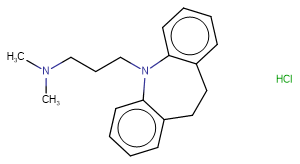
Imipramine (hydrochloride)
CAS No. 113-52-0
Imipramine (hydrochloride)( Imipramine HCl | G 22355 | Tofranil | Melipramine )
Catalog No. M21122 CAS No. 113-52-0
Imipramine (hydrochloride) is a first generation tricyclic antidepressant that acts primarily as an inhibitor of serotonin and norepinephrine transporters (Kds = 1.4 and 37 nM respectively).
Purity : >98% (HPLC)
 COA
COA
 Datasheet
Datasheet
 HNMR
HNMR
 HPLC
HPLC
 MSDS
MSDS
 Handing Instructions
Handing Instructions
| Size | Price / USD | Stock | Quantity |
| 100MG | 48 | In Stock |


|
| 200MG | Get Quote | In Stock |


|
| 500MG | Get Quote | In Stock |


|
| 1G | Get Quote | In Stock |


|
Biological Information
-
Product NameImipramine (hydrochloride)
-
NoteResearch use only, not for human use.
-
Brief DescriptionImipramine (hydrochloride) is a first generation tricyclic antidepressant that acts primarily as an inhibitor of serotonin and norepinephrine transporters (Kds = 1.4 and 37 nM respectively).
-
DescriptionImipramine (hydrochloride) is a first generation tricyclic antidepressant that acts primarily as an inhibitor of serotonin and norepinephrine transporters (Kds = 1.4 and 37 nM respectively).(In Vitro):Imipramine (0.5-300 μM, 3 days) inhibits HCT-116 cell viability. Imipramine (20 μM) inhibits cell migration (7 h) and invasion (48 h). Imipramine (50 μM, 0-240 min) inhibites the PI3K/Akt/mTOR signaling pathway in U-87MG glioma cells. Imipramine (60 μM, 24 h) stimulates U-87MG glioma cells autophagy. Imipramine (80 μM, 24 h) induces HL-60 cell apoptosis.(In Vivo):Imipramine (20 mg/kg, i.p. or 15 mg/kg, p.o.; daily for 24 days) attenuates neuroinflammatory signaling and reverses stress-induced social avoidance in mice.
-
In VitroImipramine (0.5-300 μM, 3 days) inhibits HCT-116 cell viability.?Imipramine (20 μM) inhibits cell migration (7 h) and invasion (48 h).?Imipramine (50 μM, 0-240 min) inhibites the PI3K/Akt/mTOR signaling pathway in U-87MG glioma cells.Imipramine (60 μM, 24 h) stimulates U-87MG glioma cells autophagy.Imipramine (80 μM, 24 h) induces HL-60 cell apoptosis. Cell Viability AssayCell Line:DLD-1, HCT-116, and SW-480 Concentration:0.5-300 μM Incubation Time:3 days Result:Inhibited cell viability and HCT-116 was more sensitive than DLD-1 and SW-480.Cell Migration Assay Cell Line:SW-480, DLD-1, and HCT-116 Concentration:20 μM Incubation Time:7?h Result:Produced a remarkable inhibition of migration in all assayed cell lines.Cell Invasion Assay Cell Line:HCT-116 Concentration:20 μM Incubation Time:48 h Result:Inhibited cell invasion through Matrigel.Western Blot Analysis Cell Line:U-87MG Concentration:50 μM Incubation Time:0, 15, 30, 60, 120 and 240 min Result:Markedly inhibited the phosphorylation of both Akt (Ser473) and mTOR (Ser2481) in a time-dependent manner. Also dephosphorylated p70 S6K, a downstream target of mTOR.Cell Autophagy Assay Cell Line:U-87MG Concentration:60 μM Incubation Time:24 h Result:Stimulated the induction of autophagy through the redistribution of LC3 in U-87MG glioma cells.Cell Autophagy Assay Cell Line:HL-60 Concentration:80 μMIncubation Time:24 hResult:Induced cell apoptosis.
-
In VivoImipramine (20 mg/kg, i.p. or 15 mg/kg, p.o.; daily for 24 days) attenuates neuroinflammatory signaling and reverses stress-induced social avoidance in mice. Animal Model:Male C57BL/6 mice (6–8 weeks old) subjected to RSD (repeated social defeat) and HCC (home cage control) Dosage:20 mg/kg or 15 mg/kg Administration:Intraperitoneal injection or oral administration, daily for 24 days Result:Reversed RSD-induced social avoidance behavior, significantly increasing the interaction time, significantly decreased stress-induced mRNA levels for IL-6 in brain microglia.
-
SynonymsImipramine HCl | G 22355 | Tofranil | Melipramine
-
PathwayOthers
-
TargetOther Targets
-
Recptorserotonin
-
Research AreaNeurological Disease
-
IndicationDepression
Chemical Information
-
CAS Number113-52-0
-
Formula Weight316.87
-
Molecular FormulaC19H25ClN2
-
Purity>98% (HPLC)
-
SolubilityH2O:100 mg/mL (315.59 mM);DMSO:100 mg/mL (315.59 mM)
-
SMILESCN(C)CCCN1c2ccccc2CCc2ccccc21.Cl
-
Chemical Name——
Shipping & Storage Information
-
Storage(-20℃)
-
ShippingWith Ice Pack
-
Stability≥ 2 years
Reference
1.Glassman A H . The Clinical Pharmacology of Imipramine[J]. Archives of General Psychiatry 1973 28(5):649.
molnova catalog



related products
-
Kaempferol 3,5-O-dig...
The stems of Equisetum hyemale L.
-
6-Hydroxy-4-methylco...
6-Hydroxy-4-Methylcoumarin is a useful research chemical.
-
BIM-46187 4HCl
PH-064 4HCl is a heterotrimeric G-protein complex inhibitor.



 Cart
Cart
 sales@molnova.com
sales@molnova.com


